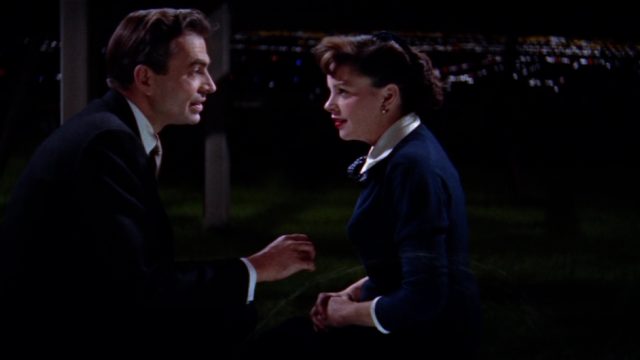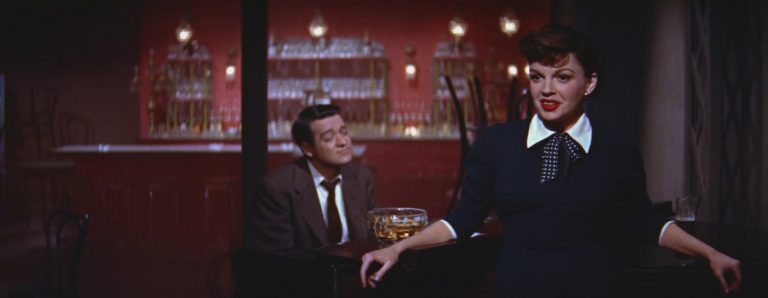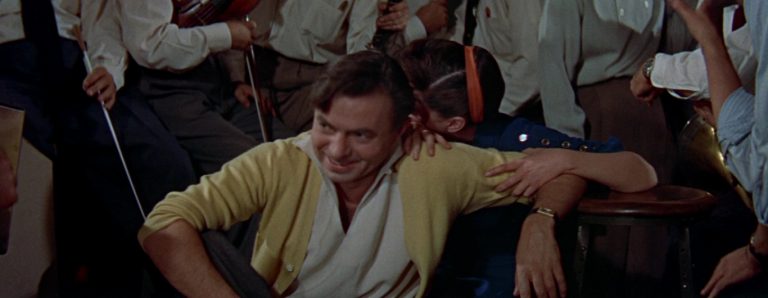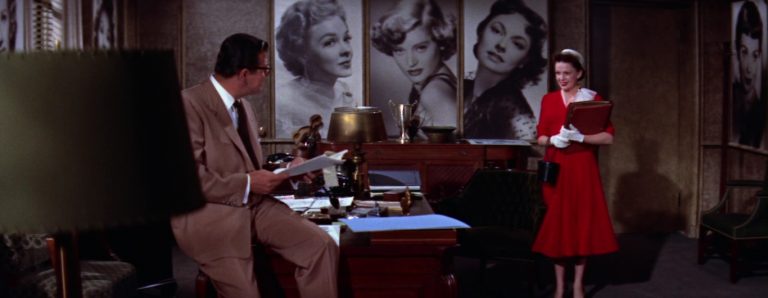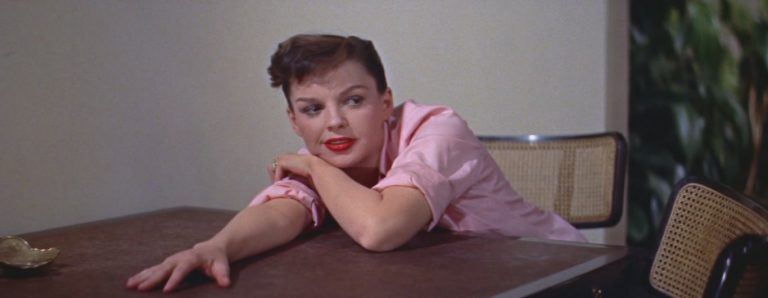When Norman Maine, a troubled, alcoholic film star whose long career is beginning to flounder, makes his first impression in George Cukor’s 1954 version of A Star Is Born, he does so by his absence. There’s a “fabulous Hollywood night,” as a radio announcer puts it, going on at the Shrine Auditorium in Los Angeles, where a benefit show is being performed “for Hollywood’s own,” but Norman, who’s expected on stage, is nowhere to be found — and when he does show up, he’s blindingly drunk, and wastes no time before he’s wreaking havoc backstage and condescending non-stop to Matt Libby, his studio’s press agent, and thus the man most responsible for maintaining his good image. Now everyone’s task has become not to get Norman in front of the audience, but to keep him away from it, and so he’s whisked away to a phony photo shoot while the act that was meant to follow him — a big band ensemble featuring singer Esther Blodgett — is moved to his spot. It is only so long, however, before he sees through the ruse, and, immediately turning from arrogantly cheerful to enraged, storms to the stage. Here’s what transpires:
A Star Is Born is a story about performers, and while by this point it has been set twice in Hollywood and twice more in the music industry, only the 1954 film is a musical about actors, and as such it brings the act of performance to the fore in a way none of the other three versions do. And in this first musical number, it already shows performance as work. As Norman stumbles into Esther’s performance (as well as her life), drama becomes a part of the musical, and what was supposed to be a light and frivolous song-and-dance number requires instant problem-solving. In a make-or-break moment, Esther, who’d earlier cracked wise when observing the drunken Norman backstage (“Looks like Mr. Maine is feeling no pain!”), summons her professionalism and saves the number by pretending that his entrance is a part of it, receiving just enough help from him when he recognizes what’s going on. (Meanwhile, the previously weightless lyrics of the song — intended, per screenwriter Moss Hart, as “the kind of rhythm number you can never hear the lyrics to” — become at once commentary and foreshadowing.) In the next scene, the indignant Esther states that she’s “never been so frightened in [my] life,” and indeed there are tiny moments in the second half of the number where you can see that she’s mortified. But the brilliance of her decision, and of the scene as a whole, is in how she helps retroactively sell that very fright, and every other awkward and improvised moment she and her equally surprised bandmates go through, as intentional, with two layers of performance melding into one right in front of the audience.
That melding also figures into the film’s second, and most iconic, musical number, albeit in a markedly different way. Hours later that same night, Esther and the band have retreated to an empty bar on Sunset Boulevard, and as they decompress, she is encouraged to sing again. “The Man That Got Away” is a torch song to end all torch songs, and Esther puts everything she has into it, but the arresting thing about her performance is that she gives much of it with a knowing, self-assured grin, at once the heartbroken woman of the song and the relaxed artist taking pleasure in channeling all her energy into embodying her, the pure, primal forces of these emotions feeding into each other. If “Gotta Have Me Go With You” is performance as work, this is performance as joy, and every subsequent song in the movie (all of which are entirely diegetic) will be one or the other or a pointed combination of the two. And if Norman could barely function in the previous number as its unwanted participant, here he is — having tracked Esther down just in time — “cold sober” (as she wryly notes when he comes out of the dark) and completely stunned as an audience member. And so begin the two core stories of A Star Is Born: that of a relationship, and that of showbiz dreams chased, realized, and paid for.
Both are ideally cast. Judy Garland and James Mason isn’t a pairing that immediately feels natural, which is why it works: Esther and Norman aren’t people who were necessarily going to cross each other’s paths, they just happened to, and, like the actors playing them, they each have considerable life and industry experience and strong personal charisma, which informs their respective attitudes and decisions and draws them to each other. One obvious question to ask this version of A Star Is Born is how a woman who sings like Judy Garland isn’t a star already; the film addresses this as part of its character and plot development, acknowledging that Esther is wildly talented but making her someone who hasn’t had lucky enough timing for more than a step-by-step career path, and has been wary of dreaming bigger until shaken up. On the other hand, this means that when Norman shows her the way she could take, she is not a wide-eyed starlet thrust into a different world, but a woman who gets a chance to improve her lot and goes for it, bringing along both newfound determination and a certain practical sense; the latter comes in handy when Norman is taken away on a location shoot before he can arrange a screen test for her, leaving her alone in L.A. for a few weeks. (“Waiting on tables… Wow, that was a low point. I’ll never forget it… And I’ll never, never do that again. No matter what,” she reflects earlier on. She will do that again.)
As for Norman, at the core of his character is pride, and Mason — cast after Laurence Olivier, Richard Burton, and Cary Grant, among others, had all passed on the role — is exactly right for that. Pride fuels both his strengths and his weaknesses, making him confident, assertive, and irresistibly suave at his best, and arrogant, dangerous, and self-destructive at his worst; in the climactic stages of the story, it is the one thing he’s got left, and the one thing that dooms him. He’s self-deprecating about the low quality of the films he stars in, and you get the sense that he’s never had to work too hard to get where he is, but Mason’s innate dignity and intelligence convey that, below the surface, Norman is aware of this, and of the fact that his work won’t leave any lasting legacy, and it eats away at him. (Those same qualities make his eventual descent all the more painful, like a betrayal that by all rights should but couldn’t have been prevented.)
That awareness, in turn, informs the degree to which he becomes invested in Esther’s career, both humbled and reinvigorated by her talent. They share a natural rapport, and part of the joy of the film’s first two hours lies simply in watching their relationship slowly grow as they spend time together at and outside of work, build up trust, trade in-jokes, become visibly more comfortable with each other; this sort of patience pays off profoundly in moments like the one when, after Esther’s triumphant movie premiere, she walks up to Norman outside the theater and simply mouths “Thank you” while looking straight into his eyes. When talk of something more than friendship between the two finally arises halfway into the 3-hour movie, it’s built on a solid foundation. All the while, there’s something curiously childlike about them, too, Esther somehow looking exactly like the teenage girl from let’s-put-on-a-show musicals for a brief moment after she’s decided to leave the band, Norman assuming a little boy’s enthusiastic expression when he applauds and repeatedly being described as looking like a child when he sleeps. (“Like a child with a blowtorch,” grimly counters Libby after he — for, presumably, far from the first time — brings the drunk actor home.) There are traces of it in the scheming way Norman gets his boss, studio head Oliver Niles, to hear Esther’s singing for the first time, and in their mischievous expressions when they announce to him that they’re getting married. (“Both of us.” “To each other!”) You could say it’s at once a consequence of the system they live in and one way they have of asserting themselves in it.
The 1954 A Star Is Born is the greatest film Hollywood has ever made about itself, for a multitude of reasons, not all of which have to do with what was intentionally put into the text. One of them is that it’s neither a valentine nor an indictment, but a film that, as much as it can, shows Hollywood as a system with its own rules, codes, and rituals, and the way that system both gets shaped by and shapes individuals. In practice, it can veer between comical (like the stop-motion shampoo commercial that Esther records a ditty for) and cruel, rewarding and ruinous. As an actor, Esther goes from hearing “I don’t wanna see your face!” and spending hours in the hands of makeup men who try to “fix” said face (their suggestions based entirely on what they’re familiar with: “the Crawford mouth,” “the Dietrich eyebrows”) to being “the hottest piece of property the studio has right now,” an incredibly telling phrase not merely for the obvious way it categorizes her but also for its reminder that her days are already numbered. Esther gives of and expresses herself, and finds success and creative validation, becoming a part of an ongoing myth, of something greater than herself. She pays for it with her agency and, inevitably, her name, the film’s ambivalent attitude expressed most succinctly in her precisely three-stage reaction to learning who will be known as from now on: “Vicki Lester?! Vicki Lester… [weary chuckle] Vicki Lester!”
The ultimate irony of A Star Is Born telling such a successful story about the Hollywood system is in how it is itself a success and a victim of that very system: a remake, conceived as a “vehicle” for a supposedly washed-up (before she even hit 30!) movie star whose experiences in the movie industry had previously driven her to a suicide attempt, made into a towering work of the medium, then carelessly carved up in order to allow for more showtimes and even today, after a painstaking restoration, only officially surviving in a wounded form, with about six minutes being black-and-white production stills and original audio. One of the most expensive films ever produced in Hollywood at the time it was made, it is at once extravagant and disciplined, an intimate drama told as an epic, sharply written and superbly acted; its storytelling and pacing haven’t aged a day.
Cukor’s supremely confident direction is crucial. Across his films, his fundamental way of working was not to intrude, but to recognize the ideal way of staging every scene and every moment presented to him; Ignatiy Vishnevetsky described him as someone who understood filmmaking “in the way a person comes to understand the world through experience,” and that comes through here. A Star Is Born was his first film in CinemaScope and his first one — in what was by that point a 25-year career — in color; watching it, you’d never guess either — there’s a predetermined, clear purpose to every composition, every camera move, every color pallette, whether it’s the smoky reds and dark blues in “The Man That Got Away” or the harmonious combination of light whites, pinks, greens and browns in Norman and Esther’s living room. This understanding that defines Cukor is complemented by the openness and authenticity that define Garland. The thing about her is not that she avoided looking like she was acting, it’s that she seemed physically incapable of it — which is not to say that she always does what you’d expect her to. This, her greatest role, is a showcase the likes of which few film actors have ever gotten, and she is, to put it simply, nothing less than mesmerizingly right every second of the way, without overshadowing any of her scene partners or calling attention to the irony of the fact that in real life, her own struggle with addiction would have made her relate much more strongly to Norman than to Esther.
Not that it needed additional emphasis, in a film where reality and image, and the private and public lives of actors, constantly overlap. In one of the most pointed scenes, Norman and Esther’s conversation during which he proposes to her gets captured and played on speakers in a recording studio full of musicians; both end up taking it in good humor, and make it a part of the romantic moment, but the fact of the brief invasion remains. Conversely, a handful of the musical numbers from the middle of the film gain their meaning as part of personal, one-on-one interactions: “It’s a New World,” Esther’s hokey radio hit, when she sings it to Norman acapella in a motel room; “Someone at Last,” a neat and ruthless parody of both Freed Unit love songs (“Somewhere, there’s a someone, who’s the someone for me…,” go the hilariously non-committal lyrics) and protracted Technicolor dream ballets, when she spontaneously stages the whole thing for him in their living room. And then, on the opposite end of those, there’s “Born in a Trunk,” the 15-minute medley shot without Cukor’s involvement as a sequence from the film-within-a-film that propels Esther to stardom. The scene is A Star Is Born at the height of both its showboating excess and dizzying irony: here we have Judy Garland selling her comeback to her peers and audiences by playing an up-and-coming actress who in turn achieves success by playing yet another (unnamed) up-and-coming actress who achieves her own success via a journey that resembles Esther’s own. It’s the story of show business ascent as a hall of funhouse mirrors.
But Garland’s, and Esther’s, true showcase moment arrives later. After what appears to have been several months of sobriety, the out-of-work Norman, his star rapidly fading, is off the wagon again, soon showing up intoxicated to the Oscars to beg his former friends for employment. (“I need a job,” he finds himself reduced to repeating, like a broken clock.) Part of the strength of the screenplay here is that, while it suggests various reasons for Norman’s alcoholism, it doesn’t offer any easy explanation or diagnosis; at the end of the day, he simply drinks, and he cannot quit, no matter how hard he tries. Sitting together with the visiting Oliver in a makeup trailer, Esther identifies this as precisely what she can’t come to terms with, unloading on both her husband and herself in a monologue filled with raw anger and desperation. All she wants is an answer; there isn’t one. And so she wipes away the tears and goes to complete the bright and happy musical number she’s been shooting, removing any trace of heartbreak from her face in fractions of a second, because she is nothing if not a professional.
There remains one other professional the story hinges on: Libby, who has spent years of his life cleaning up after Norman while the latter took him for granted, and is not inclined to feel any sympathy. Unlike Lionel Stander, who delivers an astoundingly acrid portrayal of the character in the original 1937 A Star Is Born (a film that plays as a rough draft for this one in most respects), Jack Carson here plays him as an embittered man who very understandably sees himself as the protagonist of his part of the story, and when he reappears near the end to kick Norman while he’s down, it is not contrivance of melodrama but inevitability of tragedy. Norman slips again; Esther suffers alongside him, makes sacrifices — and at the same time, crucially, refuses to be a victim, her devotion coming from strength and resolve rather than weakness. The tragedy, of course, is that devotion, too, is no answer. The story ends where it began: at the Shrine Auditorium, with Esther again in front of an audience, and her final line, in the light of all that’s transpired, more hauntingly layered than it may seem.

